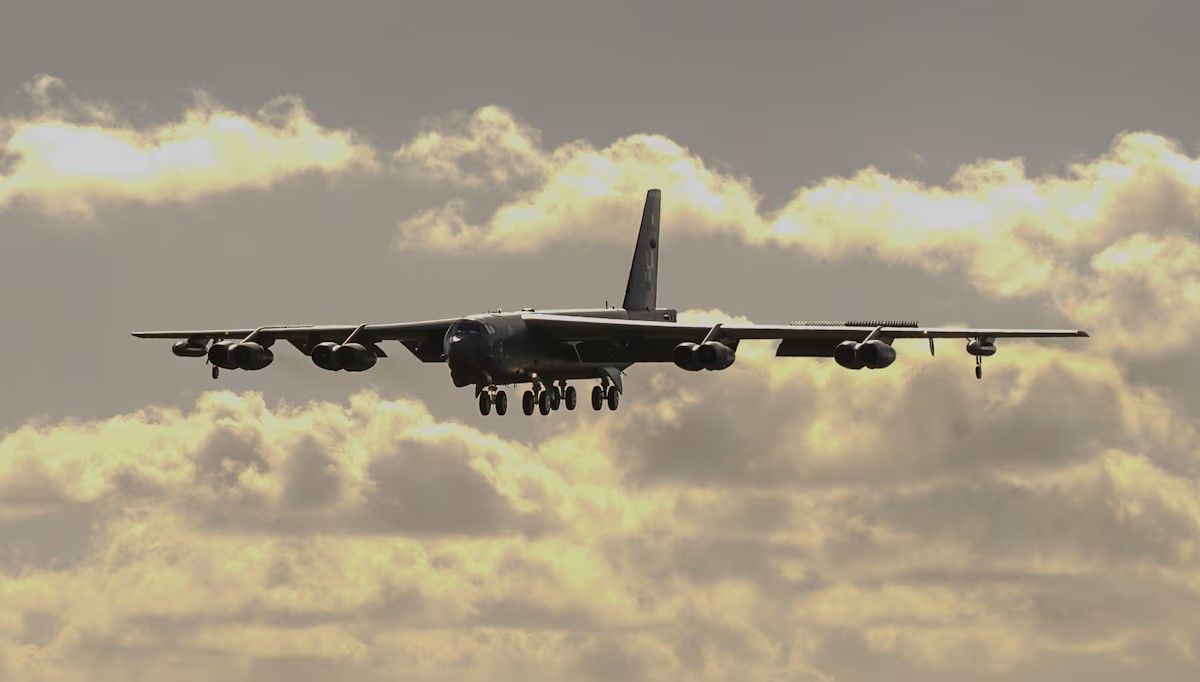Besides the AC-130 gunship, no other conventional weapon in the United States Armed Forces arsenal symbolizes “Death From Above” for America’s enemies quite like a carpet-bombing raid by Boeing’s time-honored B-52 Stratofortress, AKA the “B.U.F.F.” (Big Ugly Fat Fellow if you’re in polite company, but in reality the acronym stands for “Big Ugly Fat F*ck*r”).
Case in point: During the 1991 Persian Gulf War, AKA Operation Desert Storm, the B.U.F.F.s carried out carpet-bombing raids against then-Iraqi dictator Saddam Hussein’s elite Republican Guard troops. One particular captured Republican Guard senior officer said he surrendered his unit because of these B-52 strikes; upon being informed by his interrogator that his unit was never hit by B-52s, he replied, “But I saw one that *had* been attacked!” A PSYOPS bonus side effect, as it were!
This behemoth of a bomber — max takeoff is 488,000 lb (219,600 kilograms), and payload capacity is 70,000 lb (31,500 kg) — is a septuagenarian design, with the original prototype making its maiden flight on April 15 (Tax Day), 1952, and with the most recent (and only currently serving) variant, the B-52H, having last been produced in 1962!
Photo: US Department of Defense
In other words, the B.U.F.F. is a veritable senior citizen, way older than the young whippersnapper crew members flying it. Yet, thanks to ever-developing technological upgrades, the US Air Force plans to keep the old warbird flying until it attains centenarian status, i.e., the century mark! Simple Flying now examines how the USAF plans to make this lofty goal happen.
Upgrading the engines
We might as well start right off the bat with the biggest component of the B-52’s upgrades, eh? As noted by Stephen Losey in a February 2024 article for Defense News:
“The centerpiece of the B-52J modernization will be the replacement of the bomber’s original ’60s-era Pratt & Whitney TF33 engines with new Rolls-Royce-made F130 engines; that $2.6 billion effort is known as the Commercial Engine Replacement Program. The Air Force expects the first test B-52J will start ground and flight tests in late 2028, and for more B-52s to receive new engines throughout the 2030s.”
Although Pratt & Whitney is a well-established and time-honored producer of aircraft engines, it’s not entirely surprising that the USAF (and Boeing) are ditching them for a competing firm, given Pratt & Whitney’s recent highly publicized durability issues:
What’s more, Rolls-Royce has a legendary track record of producing premium-grade engines for warbirds, as in the Rolls-Royce Merlin engine that helped the North American P-51D Mustang fighter plane become the game changer of the air war over Western Europe during WWII.
Upgrading the weaponry
Now that we’ve covered the engine upgrade that will allow the soon-to-be B-52J to take off, reach its target, return home safely, and land, the logical next step is to discuss the upgrade(s) to the weaponry that the B.U.F.F. unleashes upon the enemy.
Among the metaphorical arrows that are potentially added to the B-52 quiver are hypersonic missiles. The BUFF has already been used to test prototype hypersonic weapons in recent years, and the Losey article cites 8th Air Force commander Maj. Gen. Jason Armagost, who “‘absolutely'” foresees hypersonics as a regular part of the Stratofortress’ future arsenal, but also tempers that enthusiasm by noting the hefty price tag that these ultra-fast weapons carry:
“‘Everything is a choice, particularly when it comes to aviation. If it flies fast or is maneuverable, everything’s a trade-off. That’s why gravity weapons probably will always be a thing.’”
Meanwhile, another weapon that’s already being added to the Stratofortress’ arsenal is the AGM-181 Long Range Stand Off Weapon (LRSO), which is a nuclear-armed air-launched cruise missile (ALCM) under development by Raytheon Technologies that will replace the AGM-86 ALCM (which was made by Boing, ironically enough). Presumably, this LRSO will have a striking range in excess of 1,500 miles (2,400 km; 1,303 NM).
Going hand-in-hand with the upgraded weaponry is the upgrade to the targeting system that enables the B-52’s smart weapons to actually hit their targets. According to an Air Force Fact Sheet last updated in June 2019:
“B-52s are equipped with advanced targeting pods. Targeting pods provide improved long-range target detection, identification and continuous stabilized surveillance for all missions, including close air support of ground forces. The advanced targeting and image processing technology significantly increases the combat effectiveness of the B-52 during day, night and less than ideal weather conditions when attacking ground targets with a variety of standoff weapons (e.g., laser-guided bombs, conventional bombs and GPS-guided weapons).”
Upgrading the odds and ends
Though not as exciting or awe-inspiring as the engines or the ordnance upgrades, “the little things go a long way,” as the idiom goes, and in the case of the B-52, the littler but still important things being upgraded include:
- Communication upgrades (“No Comm, No Bomb!” as USAF Comm officers proudly and truthfully boast)
- New digital displays replacing dozens of old analog dials
- New wheels and brakes



